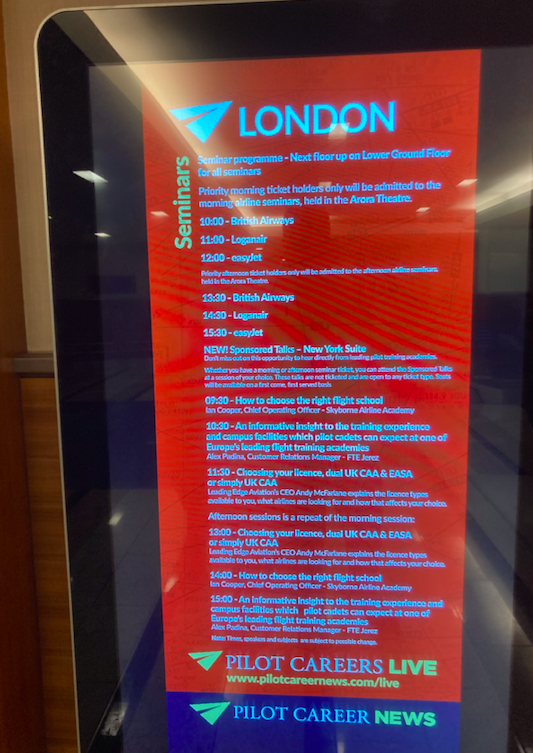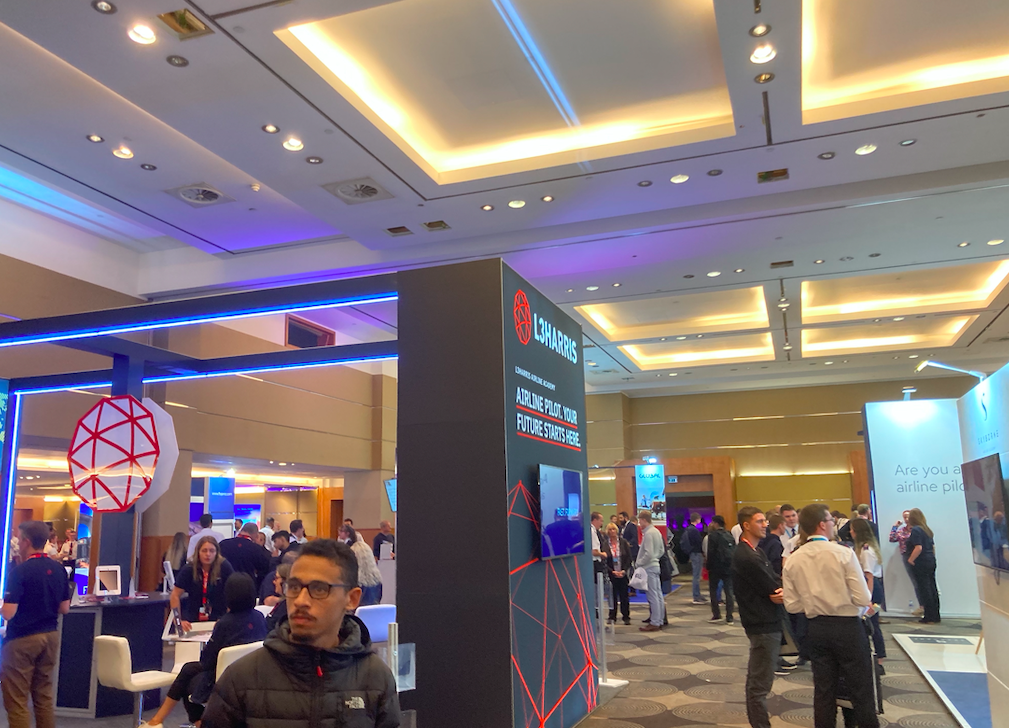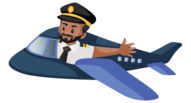Attending Pilot Careers Live – London Heathrow – 05 Nov 2022
This year Pilot Careers Live exhibition took place at Sofitel Hotel, Terminal 5 – London Heathrow Airport. For those not aware this event provides EVERYTHING one needs to know about a career as a professional pilot. This event encompasses exhibition stands by leading training organisations, airlines and universities. As well as talks and seminars by airline pilots and organisations from all over the aviation sector.
Day at Pilot Careers Live
I attended Pilot Careers Live and had access to the live seminars (AM sessions). I was at the event hall for 10.30am where I had the chance to listen to Alex Padina, Customer Relations Manager at FTE Jerez about their flight training academy. He talked around what one could expect and provided insight into training and their facilities. I later attended other talks from other schools before networking and getting to know pilots and students in the main hall.



Later in the day at 3.30pm I attended another talk by Ian Cooper, Chief Operating Officer at Skyborne Airline Academy who talked about their flying programme and training facilities in Cheltenham and in Florida, United States.
Throughout the rest of the day I was engaging with different schools, airlines organisations (such as medical), current students and active airline pilots. I was planning to stay for a few hours and ended up spending the rest of the day there!
I really hope one day I can train with a flight organisation and host an exhibition stand at PCL on their behalf. I really enjoy speaking to like-minded people and would love to pay the invaluable advice forward so that it can benefit anyone who is in a similar situation before starting training.
My experience + what I learnt from PCL
Attending the Pilot Careers Live event in November 2022 was a great experience once again for me. There’s always something new I take away from every careers event I attend. Please note this the below is my take from the event – however I would advise for anyone researching schools to directly speaking with schools/students for accuracy and up-to-date information.
What did I learn from speaking to schools, fresh graduates and students?
– Certain airlines have close affiliations with training organisations and tend to recruit from these schools. For example, EasyJet predominantly recruit CAE students. And Ryanair recruits from Atlantic Flight training Academy in Cork, Ireland. Ryanair also works with other organisations, such as Bartolini Air under the Ryanair Mentored Programme where students who choose to follow this pathway are trained in accordance with Ryanair’s SOPs to ultimately work for Ryanair (subject to interview). On the flip side I did also speak to students who were not on such programmes and had been recently recruited by Ryanair.
– General consensus and recommendation is to complete the entire modular route back-to-back without any gaps. It is important there are no significant gaps between training. This is important in order for airlines to be able to audit and look back at your training. It has to be said this is the reason I did not begin my training during university or earlier. Or in fact include flying hours from flying at the University Air Squadron. I have had another person mention this before and decided to start flying when I would be able to do so without creating massive gaps in training.
– Do the modular in a short time frame – This is rather controversial and I would deter anyone training quickly whilst neglecting quality. Having spoken to one individual I believe the idea behind this is if possible by doing the training quick – it shows determination, discipline and will. The integrated pathway is completed in 18 months – and no doubt it is intense! Whilst more and more modular students are entering the cockpit – airlines like disciplined, organised students who can handle pressured situations which of course the integrated pathway embeds throughout. So by completing the modular pathway in a similar fashion no doubt will make you stand out from other students.
– Work with Wings Alliance – this is a not-for-profit trade organisation giving students the opportunity to complete their training with approved, high quality schools. I was advised by a few people to work alongside wings alliance, and one (integrated) student secured a role at Ryanair by working with Wings Alliance. Wings alliance are important as the schools they partner with provide a comprehensive report following training – this is key for airline recruitment auditing and makes you attractive when applying. Also, it is worth signing up to webinars that Wings Alliance have recently started – these are free and different topics are covered at each webinar. Very useful.
– Work with a maximum of 3 ATOs – working with fewer ATOs the better. This is again for auditing purposes by airline recruiters during job hunts. I believe this one of the reasons airlines like integrated students since they can receive one comprehensive report from a single ATO that details the beginning to end of the training as opposed to a modular student having been to many ATOs. So ensure when joining an ATO they can provide you with a detailed report but ensure to keep it at maximum of 3.
– CPL/ME/IRR/MCC – These are the more important parts of training. And it is important these are completed at one, single ATO!
– ATPL Study: Most if not all students I spoke to reiterated the commitment needed for ATPL study. Typically students dedicate 6 months of focus and dedication with an average of 10 hours of study on weekends and similar on weekdays* (*integrated – may vary for modular). Something I picked up on a FTE Jerez seminar was students do 800 hours of ground school in total!
– I spoke to a student from an organisation who advised she has now completed her training and does flight instructing. She advised me to do flight instructing if possible – as not only is it a great way to hour build but you’re also getting paid for it! And there is always demand for flight instructors. I thought this was a pretty cool tip to bear mind (although a flight instructor’s license costs £10k so it is worth weighing the pros and cons).
– Being separated from the EU now there is an EASA license and a CAA license. For those doing ATPLs on an EASA license – they can work for a European airline (e.g. Ryanair) but cannot work for the likes of Jet2 or EasyJet. This is similar if one has a CAA license and no EASA license – cannot work for European airlines. So from the students I spoke with it seems clear some are either doing CAA ATPLs only for the time being. Whilst most students are planning to obtain the CAA and EASA license – this is achieved by completing the ATPL theory with two lots of exams (e.g. 13 EASA and 13 CAA ATPL exams). And since you pay for the theory books once you only have to pay for the sitting fee’s for the separate license. It makes sense to have two licenses in case you end up working for an EU based or a UK company – This is worth knowing when starting my ATPLs in the future. But I hope by then there is an integration of licenses to formally recognise an EASA license in the UK (one can only wish!).
I love meeting new people who share the same passion as I and are working to achieve our shared dreams.
Aside from what I learnt, I also met some great people there. For example, I was reunited with a friend I met at PCL in 2018. We had a nice catch up and I will be in touch to book in a flight sim session (where he currently works alongside working his 9-5). I also happened to see a friend I talk to on instagram – who is currently training with one of the training organisations that had set up a stand there. He has now finished training and is on the job hunt.
I also got speaking to a student from a training organisation in Norway who has now graduated and does flight instructing with them. After a good conversation we added each other on Instagram only to realise we have mutual friends. To my surprise he had attended the same school as I and only lives 15 mins away from me!
Aside from that I spoke to plenty of students – such as from Universities and recent recruits into airlines who all provided great insight in their training and their pathway through it all. Two university students I spoke with we talked about the University Air Squadron – and I shared my experience and highly recommended them to send an application. We later exchanged details in case he wanted any further help.
I would highly recommend attending a Pilot Careers Live event or if there is anything similar. These events provide invaluable information that simply cannot be found online – these are up-to-date training insights from students, tips and tricks and 1-2-1 opportunities to ask questions to schools, airlines and cadets. Aviation is a small world – once you know someone you will most likely bump into them in the future.
I hope to see you at the next Pilot Careers Live.
Blue Skies and Tailwinds.
